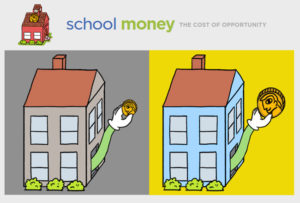 Some things just go together – cookies and milk, surf and turf, the Three Stooges (Moe, Larry, and Curly, of course)–you get the picture. At the same time, there are things that simply do not mix. When it comes to public education, two fundamental ideals fit this bill–local control and equity. Try as we might, we simply haven’t figured out, in our current public education system, how to deliver on both of these principles.
Some things just go together – cookies and milk, surf and turf, the Three Stooges (Moe, Larry, and Curly, of course)–you get the picture. At the same time, there are things that simply do not mix. When it comes to public education, two fundamental ideals fit this bill–local control and equity. Try as we might, we simply haven’t figured out, in our current public education system, how to deliver on both of these principles.
Recently, NPR launched an initiative focused on the latter, the “School Money” project. Reporters for the news outlet asked the question, why do some schools have so much, while others have so little? They summed it all up very succinctly:
“Two words: property tax”
The NPR reporters go on to say:
“The problem with a school-funding system that relies so heavily on local property taxes is straightforward: Property values vary a lot from neighborhood to neighborhood, district to district. And with them, tax revenues.”
There is just one problem with this answer–it’s wrong.
Imagine if we replaced the local property tax with a different local tax; it could be a local sales tax, a local income tax, whatever. No matter what we tax, as long as we collect it locally, independent school districts will generate different amounts of money. It is not the property tax that causes inequities. It is our very system of public education itself; it is the local school district that causes inequities.
More specifically, it is the combination of local school districts and local support for public schools which causes differences in school spending. Local school districts use the power of taxation to build new schools, to increase teacher pay, and to provide services for students. Interestingly, when given the opportunity, many local school districts tax themselves above and beyond any amount required by the state.
Here is the real kicker – the rich tend to tax themselves more. In my home state of Missouri, for example, the 50 highest spending districts have a tax rate ceiling for operating funds of $4.582 per $100 of assessed valuation. The 50 lowest spending districts tax themselves at just $3.029 per $100 of assessed valuation. These districts not only have lower property values, on average, they also choose to tax themselves less.
In other words, when we allow property rich school districts to tax themselves more and property poor school districts to tax themselves less, we allow taxpayers to willfully contribute to the inequities we see between districts.
Many people, including the authors of the NPR reports, point to the gaps in spending and take a reductionist approach to this complex system. >It’s the property tax! As much as I enjoy discussions about school finance, the issues here are much more fundamental — some people willingly choose to invest more in their children’s education than others. These people appear to sort into communities with like-minded people.
Of course, you might suggest that poor people simply cannot afford to raise their taxes as readily as their wealthier counterparts. The two groups may value education just as much as one another, but one group simply has the means to offer greater support to schools. That may be true, but it doesn’t negate the point—the combination of local school districts and local support for public schools causes differences in school spending, not the property tax.
It is easy to ask the question, “Why do some schools spend more than others?” It is much harder to answer the question, “Should we allow local taxpayers to have some say in how much they will support their local schools?” The former can be answered objectively, the latter cannot. If you say, “No,” you are saying you are uncomfortable with local control. If you answer, “Yes,” then you support some level of inequity. In the current system, we can’t have both local control and equity.
If at the end of NPR’s “School Money” project we have only answered the easy questions, we will be no better off. We will simply continue to wrestle with the same issues that we have grappled with for decades. We will continually struggle to reconcile two incompatible ideals – local control and equity.
If, however, we start to think about how the fundamental organization of our school system—a patchwork of 14,000 school districts with geographic monopolies over the residents who live within them—contributes both to spending and educational inequities and think about how we can reform that, we might be able to move the discussion forward.
— Guest Blogger James Shuls
James V. Shuls, Ph.D., is an assistant professor of educational leadership and policy studies at the University of Missouri – St. Louis and a distinguished fellow of education policy at the Show-Me Institute.


